Categories
Select a new category
Molecular Biomarker May Predict GI Symptoms in ASD
By Chelsea Toledo, M.A. on April 26, 2019
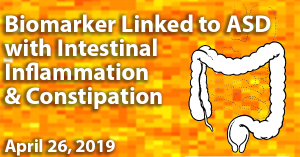
Background: For decades, researchers have suspected a link between Autism Spectrum Disorder (ASD) and gastrointestinal (GI) symptoms. The GI symptoms frequently reported in ASD include abdominal pain, constipation, chronic diarrhea, and gastroesophageal reflux disease. Some people with ASD also experience inflammation of the intestines, which respond at various rates to anti-inflammatory therapies.
What’s New: A recent study identified a biomoarker with the potential to predict which individuals with ASD and GI issues would respond quickly or more slowly to anti-inflammatory treatment. The researchers conducted molecular analyses of colon tissue samples from 35 children with ASD. Twenty of those children were found previously to respond slowly to oral anti-inflammatory medicines for GI symptoms, and 15 were fast responders.
Focusing on differences in the early stages of gene expression, the researchers found:
- Fast responders with constipation experienced timely relief after anti-inflammatory therapy, whereas constipation persisted on the right side of slow responders’ colons after treatment.
- Fast responders had greater activity of genetic material related to inflammatory and immune responses
- Slow responders had an increased number of genetic pathways related to the movement of the colon
- The presence of a single molecule could predict whether the children were slow responders to anti-inflammatory therapy.
Why it’s important: This study revealed underlying differences in genetic expression within a group of children with ASD that resulted in predictable GI outcomes. Further research may lead to specialized therapy for people with ASD and GI symptoms.
Help me understand :
| Source(s) : |
| Tweet |
Different Posture Control an Early Feature of ASD
By Chelsea Toledo, M.A. on November 29, 2018
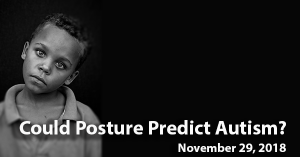
Background: Autism Spectrum Disorder (ASD) is characterized mainly by differences in communication and social behavior. However, motor delays and differences have also been observed in children with ASD. To date, studying these differences has proven difficult, with requirements for labor-intensive coding subject to human error.
What’s New: A recent study suggests that computer technology could be leveraged to gather more precise measurements of body movements by people with ASD. The researchers measured the degree to which children were able to control their posture, an indicator of neurological and muscular stability.
Focusing on 104 children between the ages of 16 and 31 months, the researchers found:
- The 22 children who were ultimately diagnosed with ASD moved their heads at much higher rates than their typically developing peers when presented with a stimulus, such as a program on a screen.
- These atypical movements appeared to be the result of a lack of muscular control, as opposed to being distracted.
Why it’s important: This article suggests that children with ASD exhibit differences in the control of their posture beginning in very early childhood. Computer technology can provide precise measurements of these patterned differences, providing a possible biomarker for ASD.
Help me understand :
| Source(s) : |
| Tweet |
Pupil Dilation in Infants linked to Autism Risk
By Chelsea Toledo, M.A. on July 11, 2018
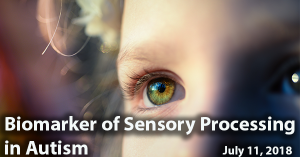
Background: Pupillometry is the study of how our eyes react to light. When it gets dark, our pupils expand; when exposed to light, they contract. Aberrations in the size of our pupils and the speed at which they react to light may reveal underlying neurological conditions. However, pupillometry has not been extensively studied in people with Autism Spectrum Disorder (ASD).
What’s New: A new study investigated whether a relationship existed between pupils’ responses to light and autism risk in very young children. The researchers classified 208 infants between the ages of 9 and 10 months as either high risk (having an older sibling with ASD) or low risk (having no older sibling with ASD). They recorded sensory responses using cutting-edge eye-tracking technology while shining a light 16 times towards the infants’ eyes. They followed up at 36 months of age, classifying the children into ASD and non-ASD groups based on their scores on standard screening and diagnostic tools.
The researchers found:
- Children who were ultimately classified into the ASD group experienced greater constriction of the pupils in response to light as infants. This finding was especially pronounced in high-risk infants who developed ASD later on.
- Constriction of the infants’ pupils was also a predictor for ASD symptom severity. Those who experienced the greatest constriction tended to have the most severe symptoms.
- Children who were classified as high risk but not diagnosed with ASD experienced different clinical outcomes than their low-risk peers, including cognitive and motor delays, attention deficits, and hyperactivity.
Why it’s important: This study highlights an autism marker – in both individuals and in families – based on sensory processing and related to the responsiveness of pupils to light in infancy. This finding could shed light on the underlying neurological basis for ASD and may eventually inform treatment approaches.
Help me understand :
| Source(s) : |
| Tweet |
Inexpensive Brain Scans Could Predict Autism Spectrum Disorder
By Chelsea Toledo, M.A. on May 23, 2018
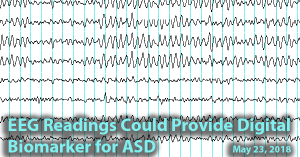
Background: A reliable biomarker for early detection of autism is critical. Electroencephalography (EEG), a technique for recording and mapping electrical activity in the brain – could provide such a measure. During this non-invasive and relatively inexpensive procedure, small metal discs called electrodes are placed on the scalp to detect fluctuations in the voltage given off by the brain’s neurons over time.
What’s New: In a new study, researchers assessed whether EEG data could accurately predict emergence of Autism Spectrum Disorder (ASD) in very young children. They performed EEG procedure on 99 high-risk children (defined as having an older sibling with ASD) and 89 age-matched controls up to seven times, beginning when the children were as young as 3 months old and ending when the children were 3 years old.
The researchers found:
- Patterns in EEG data allowed researchers to predict nearly 100 percent of ASD cases prospectively diagnosed using the Autism Diagnostic Observation Schedule (ADOS) at either 18, 24, or 36 months of age.
- The EEG data also helped predict the severity of ASD as early as 3 months of age.
- Significant differences were evident between the EEG data of the high-risk versus the low-risk group. These differences were most pronounced at 12 months of age.
Why it’s important: This study suggests that EEG could be a useful tool, along with behavioral analyses, for diagnosing ASD early. Research has shown that early diagnosis is associated with improved outcomes for children with ASD.
Help me understand :
| Source(s) : |
| Tweet |
Body Movements Could Help Detect ASD
By Chelsea Toledo, M.A. on January 25, 2018
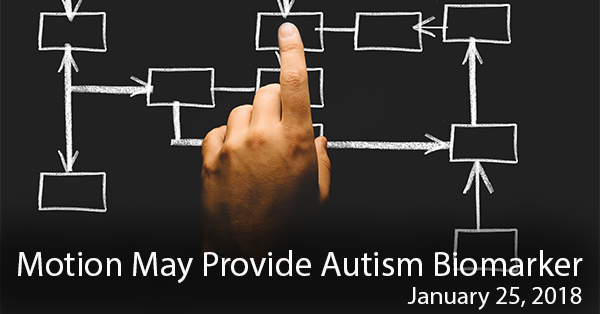
Background: Given the increasing prevalence of Autism Spectrum Disorder, or ASD, families seek early and reliable diagnosis to plan for appropriate interventions, leading to better outcomes. However, the established screening procedures are based on observation of children’s behavioral features by clinicians, so screening and diagnosis typically don’t take place until well after infancy.
What’s New: A recent study identified a biomarker that could potentially detect ASD based on movement. Wearing electromagnetic sensors on their hands, 71 individuals were instructed to point at a target on a screen repeatedly. The researchers recorded physiological information about the movements of the participants – whose ages ranged from 3 to 31, and 30 of whom had an ASD diagnosis – detecting differences that were imperceptible to the naked eye.
The researchers found:
• An algorithm was able to separate electromagnetic “noise” from the true neurological signals underlying the participants’ movements. Each individual’s movements corresponded a metric or “score.”
• The lower a participant’s score, the more likely he or she was to have an ASD diagnosis.
• Lower scores also corresponded to more severe cases of ASD.
• Moreover, 17 out of 20 parents of children with ASD undergoing the same test (who did not have ASD diagnoses themselves) showed movement patterns that differed from typical adults but were reminiscent of their children.
Why it’s important: This study suggests that extremely subtle differences in movement detected by quantitative measures can serve as potential evidence of ASD, and that there is a likely genetic component to the neurological features underlying these differences. Future research could shed light on the link between genes, neurons, and differences in movement – and could possibly point towards new avenues for early diagnosis.
Help me understand :
| Source(s) : |
| Tweet |
New Brain-Imaging Study Identifies Autism in Infants
By Chelsea E. Toledo, M.A. on March 7, 2017
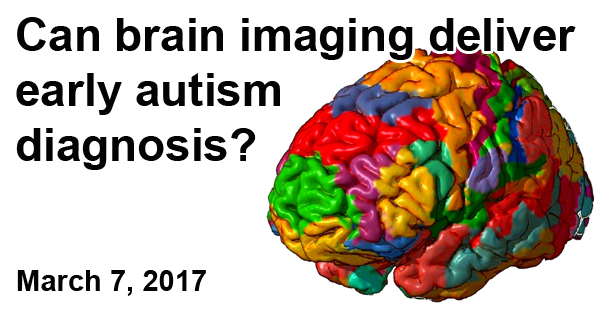
Background: Early diagnosis of Autism Spectrum Disorder (ASD) is a topic of great interest to parents and researchers alike. Studies have repeatedly shown that the earlier a child received intervention for ASD, the more benefits that child will gain related to the behavioral, communicative, and social symptoms of the disorder. However, in the United States – where one in 68 children receives an ASD diagnosis – the average age of diagnosis is 4 years old. Furthermore, standard practices aren’t yet in place for clinicians to diagnose ASD before 2 years old, when a great deal of the development of language and social skills has already taken place.
What’s new: On February 16, 2017, the journal Nature published a study outlining a potential measure for predicting ASD diagnosis before symptoms are apparent in young children. The researchers performed brain imaging at three different points in time on a total of 148 infants – 42 of whom defined as low-risk and 106 of whom were defined as high-risk, based on whether or not the infants had older siblings with ASD. Measuring the growth of the brain’s surface area at 6, 12, and 24 months, the researchers noted a trend in accelerated growth (especially in the brain’s cortex, which processes information from the environment) in the infants who were ultimately diagnosed with ASD. The researchers used this information to develop an algorithm that accurately predicted 80 percent of ASD cases in a separate group of infants.
Why it’s important: This is the first study to follow the same children from infancy to toddlerhood, tracing risk factors for diagnosis to actual clinical outcomes. Future studies could combine the researchers’ algorithm with other useful predictors (such as genetics and behavior) to improve its accuracy, with the aim of developing an early diagnostic technique.
Help me understand :
| Source(s) : |
| Tweet |
Simple iPad Game May Help Identify Children with ASD
By Shana R. Spindler, PhD on August 30, 2016
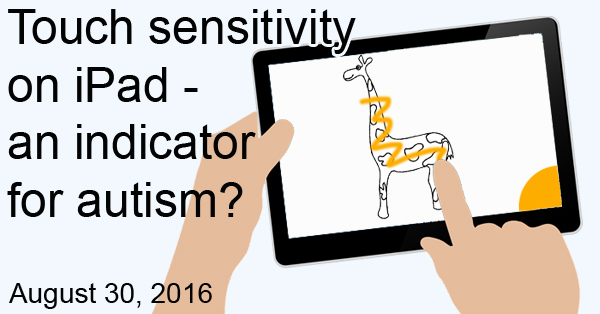
Background: More than 70 years ago, Dr. Leo Kanner described the abnormal social behaviors and movements of children with autism. Since then, many researchers have focused on the social features of the disorder. But motor control is important for many aspects of social and cognitive function. Now, several lines of evidence have shown that motor problems are present from a very young age in children who have Autism Spectrum Disorder (ASD).
What’s new: For the first time, researchers showed that hand movements on an iPad differ in children with ASD. In the study, researchers collected movement data as 37 children with ASD and 45 typically developing children played two simple iPad games. The researchers wrote a computer program that could learn from the movement data to predict if a child had ASD. Using the program, the researchers predicted ASD with up to 93% accuracy. In particular, they found that children with autism had greater contact force—how hard you press something with your finger—and larger movements with faster speed.
Why it’s important: To date, researchers can’t predict autism with high accuracy without expensive behavior monitoring. While the current study is only proof-of-concept, the results suggest that focusing on motor differences may allow researchers to identify early signs of ASD. A simple iPad game is an attractive option for screening or supplementing ASD diagnosis.
Help me understand :
| Source(s) : |
| Tweet |
Possible Blood Biomarker for ASD in Children Found
By Chelsea E. Toledo, M.A. on January 19, 2016
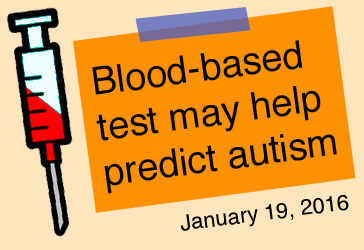
Background: Early intervention in children with autism spectrum disorder (ASD) is known to improve behavioral outcomes. Biomarkers – such as proteins in the blood or patterns of activity in the brain – may help identify children with the disorder earlier in infancy, allowing for earlier intervention. Currently, physicians do not have reliable biomarkers to use in the clinic to predict the onset of ASD in children.
What’s New: On January 14, 2016, the journal Scientific Reports published a study that detailed a possible biomarker in the blood of children with ASD. The researchers compared the blood serum from 74 boys between 2 and 10 years old with ASD, 60 of their typically developing peers, and 53 adult males between 40 and 75 years old. Using a large collection of synthetic chemical chains made in the laboratory, they found that one chain in particular, called ASD1, bound to a serum antibody with far greater frequency in typically developing boys than in those with ASD. Interestingly, the results with the ASD children resembled those of the older male group. This difference in activity allowed the researchers to identify ASD cases with 66 percent accuracy.
Why it’s important: This study builds on previous research that suggests that the immune system is different in people with ASD. Immune activity in children with ASD may resemble that of older individuals. According to the authors, measurements with ASD1, in combination with other blood-based measurements (such as hormone levels), could lead to a blood test for ASD with higher predictive accuracy for clinical use.
Help me understand :
| Source(s) : |
| Tweet |
Luteolin May Improve Behavior in ASD Subgroup
By Shana R. Spindler, Ph.D. on October 8, 2015

Background: Individualized management is an important goal for those with Autism Spectrum Disorder (ASD). While we don’t yet have standardized ASD subgroups, several lines of evidence suggest that inflammatory molecules may serve to distinguish some ASD populations.
What’s new: On September 29, 2015, the journal Translational Psychiatry published a study on the effect of luteolin supplementation on children with ASD. The antioxidant luteolin is a powerful anti-inflammatory agent naturally found in some foods, including celery, broccoli, and navel oranges. The researchers found that a subgroup of children with ASD had high blood levels of inflammatory molecules—known as IL-6 and TNF—which decreased significantly after luteolin treatment. The children with the greatest decrease in IL-6 and TNF showed the most improvement in communication, daily living skills, and social behaviors.
Why it’s important: This study combines two important topics in autism research: subgroup identification and individualized treatment. An inflammation-based biomarker in individuals with ASD could help predict prognosis following anti-inflammatory treatments. The results of this study support the need for a larger, double blind, randomized, placebo-controlled trial.
Help me understand :
| Source(s) : |
| Tweet |
Newly Found Biomarker May Aid in Autism Diagnosis
By Chelsea E. Toledo, M.A. on October 1, 2015
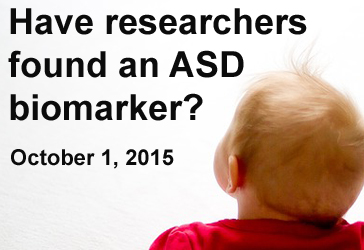
Background: Autism spectrum disorder (ASD) is a neurodevelopmental condition characterized by social, communicative, and behavioral differences. Research has shown that certain activity within the brain – where calcium signaling plays a significant role in communication between neurons – is dysfunctional in ASD, impacting learning and memory.
What’s New: On September 22, 2015, the journal Translational Psychiatry published a study exploring a defect in calcium release as a possible biomarker for ASD. The researchers examined skin cells from male Caucasian donors with different genetic variations of the disorder, as well as from typically developing controls. They discovered a defect in calcium signaling within cellular membranes in the skin samples taken from donors with ASD.
Why it’s important: The cellular location of the defect – in a part of the cell called the endoplasmic reticulum – has been linked to cognitive, digestive, and immune function. While no widely accepted biomarkers currently exist for ASD, further study of the calcium signaling defect could lead to early diagnostics and targeted treatments for the disorder.
Help me understand :
| Source(s) : |
| Tweet |
Level of Hormone Predicts Theory of Mind Ability in ASD
By Shana R. Spindler, Ph.D. on August 13, 2015
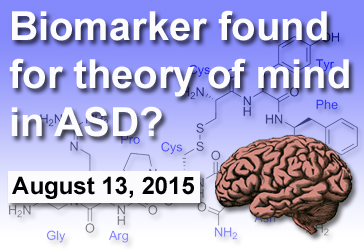
Background: Difficulty with social functions is a defining characteristic of Autism Spectrum Disorder (ASD). Hormones in the brain, such as oxytocin and arginine vasopressin, play an important role in regulating social behaviors in humans and other mammals. While several studies have focused on the potential role for oxytocin in the diagnosis and treatment of ASD, few investigations have centered on arginine vasopressin.
What’s new: On July 22, 2015, the online journal PLOS ONE published a study examining the relationship between blood levels of arginine vasopressin (AVP) and social abilities in those with ASD, their siblings, and neurotypical controls. The researchers first confirmed that blood levels of AVP predicted brain levels of the hormone. Next, they found that ASD individuals with lower blood levels of AVP have decreased Theory of Mind—the ability to interpret another’s intensions and emotions. This correlation is specific only to Theory of Mind ability, as AVP blood levels did not predict other social function scores.
Why it’s important: ASD is a heterogeneous condition—individuals along the spectrum have varying degrees and combinations of symptoms. Consequently, there is individual variability in Theory of Mind. Having a biomarker for this nearly universal feature of ASD will be important for diagnosis and treatment selection. This study suggests that the blood level of arginine vasopressin could be a biomarker for theory of mind ability in individuals with autism.
Help me understand :
| Source(s) : |
| Tweet |
Autism Could be Indicated by Sniffing Patterns
By Chelsea E. Toledo, M.A. on July 14, 2015
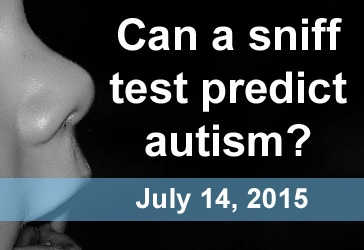
Background: Sensory-motor coordination involves integration between the parts of the brain that receive and interpret stimuli and those that facilitate action in response. For example, upon touching a hot surface, people immediately remove their hands. Studies have suggested that sensory-motor coordination is atypical in people with autism spectrum disorder (ASD).
What’s New: On July 2, 2015, the journal Current Biology published a study exploring the response to odors in children with and without ASD. The researchers used a device to measure the time to sniff and duration of sniff for 36 children between the ages of 4 and 11 who were presented with pleasant and foul odors. They found that the 18 typically developing children followed the same sniffing patterns seen in adults; they would sniff pleasant odors for longer periods of time, but respond with brief sniffs when presented with foul odors. The 18 children with ASD, however, sniffed both pleasant and foul odors for the same amount of time. Using the device, the researchers were able to predict 81 percent of ASD cases.
Why it’s important: This study suggests that the olfactory response is different in children with ASD, with more pronounced differences in children with higher degrees of social impairment. Future research could determine whether the researchers’ method, which requires no verbal response, could be used to help diagnose the disorder in very young children to allow for early intervention.
Help me understand :
| Source(s) : |
| Tweet |
ASD Linked to Fewer Gestures in Infancy
By Chelsea E. Toledo, M.A. on May 19, 2015
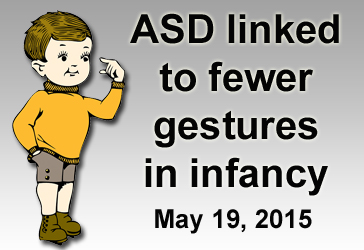
Background: One of the trademark symptoms of Autism Spectrum Disorder (ASD) is impaired communication, which is accompanied by difficulty with social interaction and restrictive, repetitive behaviors. Although ASD is typically not diagnosed until later in childhood, language delay can present itself as early as the first year of life.
What’s New: The January 2015 issue of the Journal of Autism and Developmental Disorders included a study examining the relationship between language production and the gesture use by infants and their caretakers earlier in life. The researchers performed observational screenings on a total of 75 infants—48 who had a sibling with ASD and 27 who did not. During observation, the researchers evaluated maternal and infant gestures at 12 months of age and the children’s subsequent language production at 18 months of age.
The research team found that the infants who later fit the ASD profile produced the fewest gestures, and that the use of gestures by mothers only affected the language production of the infants who did not fit the ASD profile. They also observed that mothers of the infants deemed high-risk for ASD by virtue of having a sibling with the disorder tended to produce more gestures, such as pointing and nodding when interacting with their children.
Why it’s important: This study reinforces other research suggesting a delay in gesture production in infants who would ultimately receive an ASD diagnosis. Future research could illuminate intervention strategies based on interactive gesturing by caretakers.
Help me understand :
| Source(s) : |
| Tweet |
Researchers Probe Blood Biomarkers for ASD
By Chelsea E. Toledo, M.A. on February 9, 2015
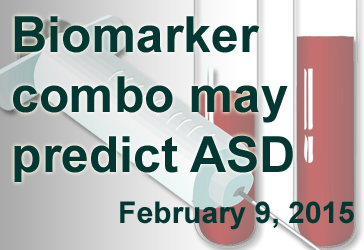
Background: At present, the only way to diagnose autism spectrum disorder (ASD) is through a series of behavioral screenings administered by trained professionals. While no laboratory test for ASD is currently available, recent studies have suggested that certain features detected in the blood could prove reliable as biomarkers for the disorder.
What’s new: The January 2015 issue of Neuroscience included a study evaluating two components in blood, serotonin and interleukin-6, as biomarkers for detecting ASD. While serotonin helps to regulate mood, interleukin-6 plays a role in the body’s inflammatory response to invading pathogens. The researchers performed blood tests on a total of 66 individuals—35 with ASD and 31 with typical development—whose average age was 12. They found that levels of serotonin and interleukin-6 were significantly elevated in the individuals with ASD, and were highest in those with the most severe forms of the disorder.
Why it’s important: The study found that, when taken together, serotonin and interleukin-6 were very reliable biomarkers for ASD—as blood tests looking for both molecules were accurate nearly 90 percent of the time. This work could lead to a clinical blood test for ASD risk, and could point the way to treatments targeting serotonin and interleukin-6.
Help me understand :
| Source(s) : |
| Tweet |
Researchers Search for Autism Blood Test
By Chelsea E. Toledo, M.A. on November 15, 2014

Background: Studies have shown that children with autism spectrum disorder (ASD) experience better outcomes the earlier they receive a diagnosis. Using currently available assessments—which include evaluations of language, behavior, and intellectual abilities—clinicians diagnose children with ASD at the average age of four.
What’s new: On November 7, 2014, the open-access journal PLoS One featured a study exploring techniques to find markers for ASD in the blood of affected individuals. The researchers compared the blood plasma of 39 children with ASD to that of 22 typically developing peers and found 179 features differentiating their blood. Using five different laboratory tests, the scientists tested for those same features in the blood of another set of children—13 with ASD and 8 with typical development—and were able to accurately classify them more than 80 percent of the time.
Why it’s important: This study moves the field closer to having a blood test for ASD, which would allow for earlier diagnosis and intervention. Future studies could refine which combination of biomarkers and which laboratory tests result in the most accurate diagnosis.
Help me understand :
| Source(s) : |
| Tweet |
Possible Autism Biomarker in Tiny Regulators
By Shana R. Spindler, PhD on September 10, 2014
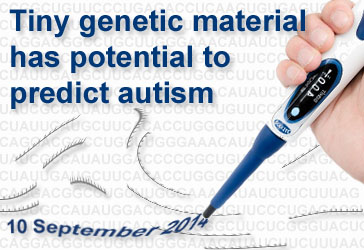
Background: Several studies have shown that early intervention helps children with Autism Spectrum Disorder (ASD) improve critical social and language skills. Unfortunately, doctors still lack a non-behavioral clinical test to find out if a child has or will develop ASD. Diagnosis is therefore delayed until the child reveals social or language deficits, usually by two to four years of age. Researchers are now searching for autism biomarkers, an objective measurement that can predict the likelihood that a child has autism, even before behavioral symptoms used for diagnosis appear.
What’s new: A group of Japanese researchers report in Molecular Autism that a new class of small gene regulators, called microRNAs (miRNAs), may help predict ASD. The team of scientists found that individuals with autism had higher levels of eight specific miRNAs in serum samples compared to control individuals. In contrast, five miRNAs showed lower levels in those with autism. MicroRNAs are like little zip ties that bind gene products to control the cell from making certain proteins. The researchers identified several proteins involved in neuron biology among the protein targets affected by the miRNAs in this study.
Why it’s important: To date, the medical community lacks a biomarker of any type for autism. This is the first study to show that specific miRNAs are found at different levels in the serum of those with autism versus controls. Serum collection is a relatively safe and noninvasive procedure. These results suggest that the measurement of serum miRNAs may serve as a biomarker for autism, but additional studies are needed to confirm this finding.
Help me understand :
| Source(s) : |
| Tweet |
Researchers Explore ASD and GI Symptoms Link
By Chelsea E. Toledo, M.A. on May 8, 2014
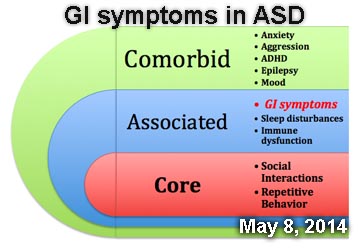
Background: For over thirty years, researchers have suspected a link between Autism Spectrum Disorder (ASD) and gastrointestinal (GI) symptoms. The GI symptoms frequently reported in ASD include abdominal pain, constipation, chronic diarrhea, and gastroesophageal reflux disease. Recently, The National Institutes of Health has prioritized research exploring GI symptoms in people with ASD.
What’s new: On May 2, 2014, the journal Pediatrics published a meta-analysis of GI symptoms in ASD, examining 15 studies conducted between 1980 and 2012. In all, the analysis included data from 2215 children with ASD, whose GI indicators were compared to those in children without ASD. The researchers found that, when all studies were taken into consideration, children with ASD were much more likely than their typically developing counterparts to experience general GI symptoms—as well as specific symptoms such as diarrhea, constipation, and abdominal pain.
Why it’s important: This study is the first thorough evaluation of the evidence suggesting that GI dysfunction is more common in children with ASD. More research is needed to determine why GI symptoms appear more common in people with ASD, as well as their long-term effects.
Help me understand :
| Source(s) : |
| Tweet |
Eye Fixation is Lost, Not Absent, in ASD
By Shana R. Spindler, Ph.D. on November 15, 2013
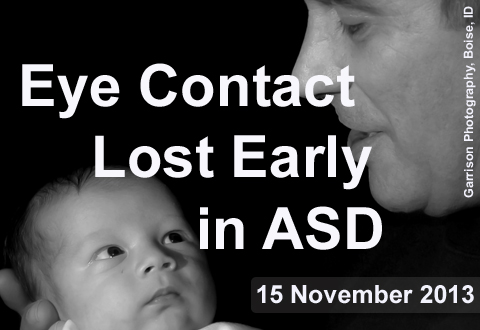
News Brief: A new article in the high impact journal Nature has received a lot of coverage in the media recently, for good reason. United States researchers revealed that poor eye contact observed in children with Autism Spectrum Disorder (ASD) results from a gradual decline in eye fixation in two to six-month-old infants. Their findings suggest a potential window for early intervention in ASD before this social behavior is lost. It remains unclear, however, if addressing eye fixation deficits will improve other ASD-related behaviors.
Help me understand :
| Source(s) : |
| Tweet |
Study Supports Role of Maternal Autoantibodies in ASD
By Shana R. Spindler, Ph.D. on July 25, 2013
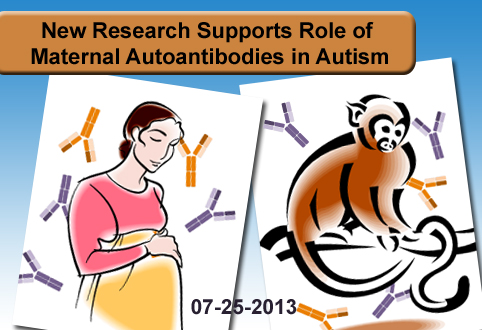
Background: Over the past several years, researchers have presented correlation between the existence of autoantibodies in mothers and an increased diagnosis rate of Autism Spectrum Disorder (ASD) in their children. Autoantibodies are Y-shaped proteins of the immune system that bind one or more of the body’s own proteins. Researchers hypothesize that autoantibodies can pass through the developing blood-brain barrier of a fetus and inhibit the function of proteins important for brain development.
What’s new: Two back-to-back studies published on July 9, 2013, in the journal Translational Psychiatry provide compelling support for the hypothesis that maternal autoantibodies contribute to ASD risk. The first study examined which proteins of the body are targeted by the autoantibodies. The researchers reported that each of the target proteins identified has a known role in neuron development and/or function. Mothers with certain combinations of autoantibodies were more likely to have children with stereotypical ASD behaviors than mothers who did not carry those same autoantibody combinations.
In the second study, researchers tested the causative role of autoantibodies in ASD by injecting purified antibodies from mothers who have children with ASD (called IgG-ASD) into pregnant rhesus monkeys. As a control, researchers injected purified antibodies from mothers of typically developing children into a separate group of pregnant monkeys. The monkeys born to mothers injected with IgG-ASD had more difficulty forming reciprocal social interactions than did the monkeys born to mothers injected with control IgG. Upon further examination, the researchers found that male monkeys born to mothers injected with IgG-ASD had increased white matter volume in the frontal, occipital, and parietal lobes of the brain.
Why it’s important: These two studies are remarkable for three important reasons: First, the fact that specific combinations of maternal autoantibodies are predictive of an ASD diagnosis in children suggests that autoantibodies are a promising biomarker candidate for some cases of autism. Second, while many studies are only correlative, the experiment in pregnant rhesus monkeys suggests a causative mechanism in the link between mothers’ autoantibodies and ASD in their children. Third, pharmacological intervention to block autoantibody activity offers new therapeutic opportunities for maternal autoantibody-related autism.
Help me understand :
| Source(s) : |
| Tweet |
Autism Linked to Atypical Visual Attention in Infancy
By Chelsea E. Toledo, M.A. on April 18, 2013
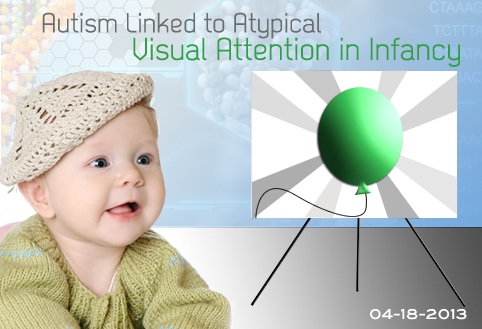
Background: Along with its hallmark social and communicative impairments, autism spectrum disorder (ASD) is commonly associated with a narrow focus of attention and interest. Studies of autistic adults have demonstrated that they experience increased activation in brain areas known for processing local versus global information—a pattern linked to superior performance on detail-oriented tasks.
What’s New: On January 29, 2013, the journal Biological Psychology featured a study of visual attention in infants, and its relation to ASD diagnoses later in life. The researchers videotaped 104 infants between six and 15 months of age as they watched animations either in the center of a screen or in its periphery. They found that the infants who were later diagnosed with ASD were more likely than their typically developing peers to continue focusing on the center of the screen after an animation moved to the periphery, and that they displayed inconsistent speed and flexibility in visual orientation.
Why it’s important: This study suggests that infants who develop autism have atypical development of visual attention beginning in the first year of life. However, infants who were later diagnosed with other developmental syndromes showed similar patterns in visual attention, underscoring possible overlaps in childhood disorders.
Help me understand :
| Source(s) : |
| Tweet |
Parents of Children with ASD Want Genetic Testing
By Stacy W. Kish on December 14, 2012
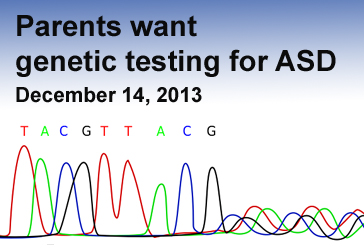
Background: The diagnosis of Autism Spectrum Disorder (ASD) by behavioral observations often comes years after the parents suspect a problem with their child’s development. However, children diagnosed at a younger age can begin receiving interventions that show improvement in language skills, adaptive behavior, and IQ scores. Parents with one child diagnosed with ASD report increased rates of anxiety for their younger children.
What’s new: Genetic testing is a major area of focus in ASD. In this study, researchers surveyed parents with at least one autistic child to gather parents’ input on their interest in a genetic test. Overwhelmingly, 80 percent of parents with one autistic child would consider genetic testing if it becomes available to help establish the risk of the disorder in younger children. Parents also seek clear and honest answers from their doctors.
Why it’s important: Parents are interested in a genetic test that could indicate risk of ASD, even if the test cannot confirm a diagnosis. Diagnosing children at a younger age improves intervention treatments and parental acceptance of the diagnosis.
Help me understand :
| Source(s) : |
| Tweet |
Cord Blood Testosterone Level Fails to Predict ASD
By Mark N. Ziats on November 14, 2012
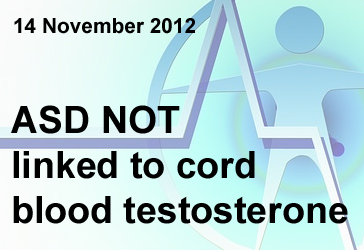
Background:
More males than females are diagnosed with autism, at a rate of at least 4:1. This significant gender difference, along with previous animal and human studies of sex differences in brain development, has led researches to speculate that children with Autism Spectrum Disorder (ASD) may be exposed to more testosterone—the chief male sex hormone—than unaffected children.
What’s new:
In a study published in the Journal of Neurodevelopmental Disorders on 30 October 2012, researchers measured testosterone in the umbilical cord blood of 707 newborns and then followed the cohort for 20 years to determine if the testosterone level at birth correlated with a future diagnosis of ASD or presence of autistic traits. The researchers found that testosterone levels were not associated with an ASD diagnosis nor related to the development of autistic-like traits in those subjects without a diagnosis of autism. However, only five of the 707 newborns developed autism. A follow-up study with greater numbers is important to validate these findings.
Why it’s important:
This research suggests that the level of testosterone at birth does not correlate with the development of autism. Additional studies are needed to determine if testosterone levels during the early stages of pregnancy play a role in ASD risk.
Help me understand :
| Source(s) : |
| Tweet |
Specific Genetic Variations May Help Predict ASD
By Shana R. Spindler, Ph.D. and Mark Ziats on October 12, 2012
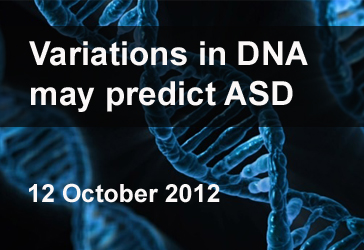
Background: The diagnosis of Autism Spectrum Disorder (ASD) is currently based on clinical interviews. Doctors lack laboratory tests or other biomarkers to help support a diagnosis. Autism has a strong genetic component, but knowing which genetic variations contribute to or protect against autism is a major challenge for diagnosis.
What’s new: Scientists have developed a diagnostic test by mapping genetic variations into cellular pathways that might be affected in autism. A specific combination of 237 common genetic variations, called single nucleotide polymorphisms (SNPs), can predict an ASD diagnosis with at least 71 to 85 percent accuracy, according to a new study published 11 September in Molecular Psychiatry. The predictive accuracy, however, is only strong in those genetically similar to Central Europeans. The same SNPs predicted ASD with only 57 percent accuracy in a genetically dissimilar Chinese population. According to the authors, at least some of the genes harboring autism-linked SNPs are expressed in various brain regions implicated in ASD, and those genes are also important for cellular processes required for proper neuron functioning.
Why it’s important: An SNP profile may eventually become an important biomarker in the diagnosis of ASD. SNP testing during early infancy could allow detection of ASD before symptoms manifest, allowing for earlier therapeutic intervention, which may increase the success rate of therapy.
Help me understand :
| Source(s) : |
| Tweet |
Brain Differences Found in Infants who Develop Autism
By Catherine Croft Swanwick, Ph.D. on February 17, 2012
Overview: Differences in brain connectivity can be detected as early as six months of age, according to a study published today in the American Journal of Psychiatry.
Background: As part of the Infant Brain Imaging Study (IBIS) Network, researchers at the University of North Carolina-Chapel Hill have been tracking infants at high risk of developing autism spectrum disorders (ASD) because an older sibling is affected. They imaged the brains of 92 such infants using a technique called diffusion tensor imaging (DTI). DTI labels white matter fibers within the brain, allowing the visualization of brain connectivity.
What’s New: The 28 infants who were later diagnosed with ASD showed a distinct pattern of brain connectivity when six months old, as well as abnormal brain development through 24 months of age.
Why It’s Important: This suggests that brain imaging can potentially be used to detect “biomarkers” for autism, allowing early detection and treatment for infants before symptoms appear.
Help me understand :
| Source(s) : |
| Tweet |

